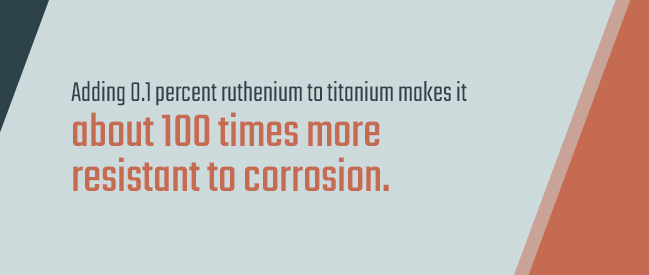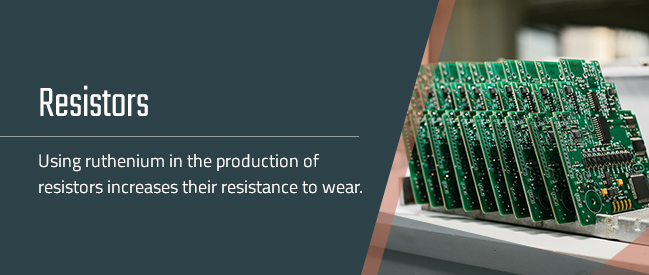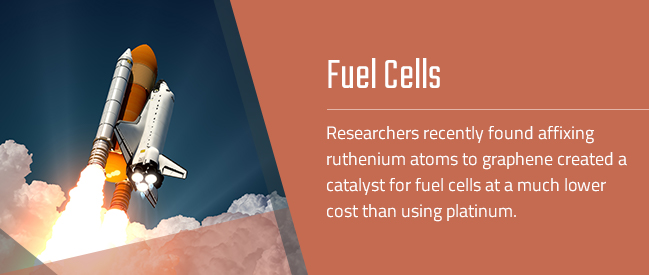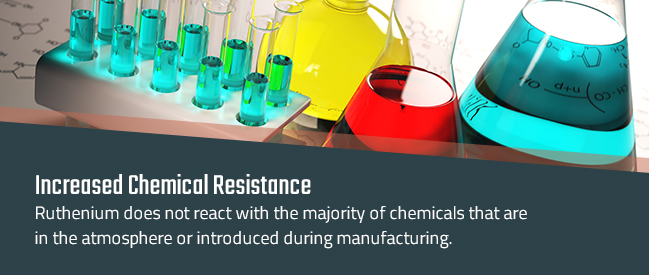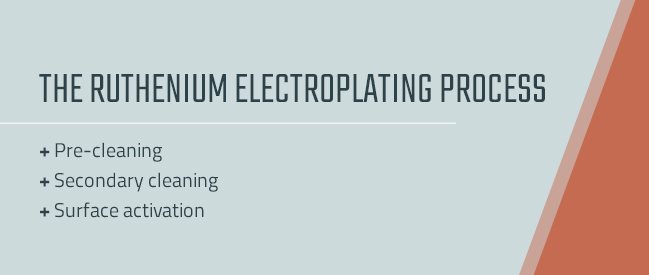Ruthenium is less well-known and rarer than many other precious metals, but you should certainly consider it if you require metal plating for aerospace and aircraft industry applications. This platinum group metal is exceptionally durable and has a number of other useful features as well. These properties make it valuable to a variety of sectors, including the aerospace industry. Ruthenium has a range of current uses, as well as others that are currently in development related to aerospace equipment. Learn more about ruthenium plating and its applications in the aerospace and aircraft industry below.
What Is Ruthenium?
Ruthenium is a rare transition metal that belongs to the platinum group of metals. It is also known by its chemical element symbol, Ru, and has an atomic number of 44.
Ruthenium is hard and brittle in its metallic state and has a shiny, silvery-white metallic appearance as well as a high melting point. Like the other platinum group metals, ruthenium is chemically inert, so it does not react with most chemicals it may encounter in the atmosphere and during manufacturing processes. Acids do not affect ruthenium, but potassium chlorate can cause extensive oxidation. Ruthenium won’t tarnish if kept at room temperature.
Ruthenium comes from ores that are most often found in the Ural Mountains in Western Russia, but also exists in parts of North and South America. It also comes from pyroxenite deposits in South Africa. Isolating ruthenium for commercial use involves a fairly complex chemical process.
Ruthenium has a low crustal abundance of approximately 0.001 part per million. Despite this relative rarity, its price is typically lower compared to other similar metals.
Karl Karlovich Klaus, also sometimes called Carl Ernst Claus, typically gets credited with discovering ruthenium. He did so in 1844 Kazan State University in Russia. Klaus, a Russian-born scientist of German descent, named ruthenium for the Latin name for his homeland of Russia.
Ruthenium has various uses. It is often alloyed with platinum and palladium to harden them and used to produce electrical contacts that are highly wear-resistant. Adding 0.1 percent ruthenium to titanium makes it about 100 times more resistant to corrosion. It can also act as a catalyst for various chemical processes, including splitting hydrogen sulfide and removing it from industrial processes such as oil refining. Its durability and high melting point also make it a useful metal for the aerospace and aircraft industry.
Applications in the Aerospace and Aircraft Industry That Use Ruthenium
The aerospace and aircraft industry uses ruthenium for various purposes and in numerous applications. There are many established uses, as well as some that are currently in the research and development stage and will likely make a substantial impact in the future.
Aerospace applications require materials that are highly durable, even under high temperatures and other harsh conditions. Adding ruthenium to platinum, palladium and other metals increases their hardness, resistance to heat and resistance to corrosion. The aerospace and aircraft industry often uses ruthenium alloys for this purpose.
Here are a few of the specific applications of ruthenium in the industry.
Electrical Contacts
The aerospace and aircraft industry can use ruthenium for electrical contacts, as do various other industries. Using ruthenium for producing electrical contact surfaces increases their resistance to wear. This durability improves the reliability of aerospace electrical equipment, even under the high-stress conditions it often encounters.
Resistors
Resistors, which are integral components of electronic circuits, can make use of ruthenium and ruthenium alloys. Electrical resistors can reduce current flow, adjust signal levels, dissipate electrical power as heat and perform a variety of other useful functions as well. As with electrical contacts, using ruthenium in the production of resistors increases their resistance to wear.
Wiring
Wiring containing ruthenium and ruthenium alloys has increased durability and higher temperature resistance, which is crucial in aerospace applications. Recent research suggests ruthenium may be a valid replacement for copper in electrical interconnects, wires that connect electrical components. Ruthenium eliminates some of the problems associated with using copper because of its low bulk resistivity, high melting point and smaller mean free path, which reduces sensitivity to size effects.
Semiconductors
Ruthenium is often used as a plating material in the production of semiconductors because of its low resistivity, high work function, durability and other beneficial properties.
Recently, researchers discovered adding a ruthenium compound to organic semiconductors greatly increased their conductivity. They added the compound through a process called doping, which modifies the semiconductor’s chemical makeup by introducing new chemicals. When they added the ruthenium compound as a dopant, it acted as a reducing agent and introduced additional electrons to the organic semiconductor.
Turbines
Another emerging use of ruthenium in the aerospace industry is its use in high-temperature single-crystal superalloys used in the production of turbines for jet engines. The NASA Joint Development Project developed the nickel-based alloy, which contains 3 percent ruthenium and 6 percent rhenium. This fourth-generation alloy was the first time ruthenium was included. This alloy has a higher temperature capability and lower creep rate than previous versions. It makes turbine blades more durable and increases aircraft efficiency.
Fuel Cells
Ruthenium could also play a key role in the production of fuel cells, a technology currently undergoing research and development that could have uses for all types of transportation, including air and space travel. Researchers recently found affixing ruthenium atoms to graphene created a catalyst for fuel cells at a much lower cost than using platinum. The catalyst is what starts the oxygen reduction reaction that leads to the fuel cell turning chemical energy into electricity.
Benefits of Plating With Ruthenium
Why use ruthenium plating? This material has numerous benefits that can be useful in many sectors, especially the aerospace and aircraft industry. Many of these advantages revolve around its durability and resistance to conditions that would damage other materials, as well as other beneficial aspects.
Increased Hardness
Ruthenium has a hardness of about 220 on the Vickers scale and a tensile strength of 53,700 pounds per square inch. It is often added to metals such as platinum and palladium to increase their hardness. Applying ruthenium plating to a substrate makes it harder and more durable, a necessity for many aerospace applications.
Increased Wear Resistance
Ruthenium’s resistance to wear is one of its most sought-after properties. It’s one of the main reasons the electronics industry uses it so often. It frequently serves to increase the wear resistance of electrical contacts, resistors and other electrical components. This enhanced resistance to abrasion makes these components more durable and increases their useful life. In aerospace applications, electrical components must withstand harsh conditions while continuing to function reliably.
Increased Chemical Resistance
Ruthenium does not react with the majority of chemicals that are in the atmosphere or introduced during manufacturing. These chemicals can damage some other materials, but ruthenium is chemically inert, so they do not affect it. It does not react to acids and does not easily tarnish.
Increased Corrosion Resistance
Aerospace equipment can be at risk for corrosion, which can cause structural integrity problems and other forms of severe damage to components. Adding a layer of ruthenium can increase a material’s resistance to corrosion substantially. Even a small amount of ruthenium electroplating in aerospace can greatly increase corrosion resistance, which increases equipment’s lifespan and helps ensure it can operate safely.
Increased Temperature Resistance
Aerospace equipment is regularly exposed to high temperatures and must be able to withstand them to function properly. Adding ruthenium to materials used in aerospace applications can give them this vital capability. Ruthenium has a melting point of 4,233 degrees Fahrenheit and a boiling point of 7,502 degrees Fahrenheit, so it can increase many materials’ resistance to high temperatures.
Enhanced Aesthetic Appearance
Although typically less important in the aerospace sector than in other industries, ruthenium’s aesthetic appeal also contributes to its popularity. Ruthenium naturally has a bright, silvery-white color. By altering the plating bath, you can also create a ruthenium plating with a dark gray or even black color. This darker plating is sometimes an alternative to black nickel. Applying various surface treatments to ruthenium plating can enhance its appearance even more.
Because of ruthenium’s durability and resistance to changes such as tarnishing, it keeps its appealing looks for an extended period. Ruthenium coatings typically have a thickness of between 0.25 and one micron.
Affordability
Despite its rarity, ruthenium is relatively inexpensive compared to other similar materials. While cost may still be a limiting factor for some customers, it often serves as a more affordable replacement for other precious metals, while still providing the benefits those more expensive metals would.
The Ruthenium Electroplating Process
Plating ruthenium involves a process known as electrodeposition. This electroplating process deposits a thin layer of metal onto whatever substrate is used. The substrate is the material to which the ruthenium gets plated.
Before applying plating to a substrate, it is necessary to prepare the surface. Various factors impact the preparation steps you need to take, but the process typically involves three steps: pre-cleaning, secondary cleaning and surface activation. The first steps remove contaminants from the surface and, in some cases, polish it. In some situations, you may also need to activate the surface to achieve certain goals such as improved adhesion or electrical conductivity.
Once you’ve completed any necessary preparation, you can move on to the actual electrodeposition process, which involves an electric current and a chemical bath.
We first connect the ruthenium to an electrode with a positive charge, known as the anode. The substrate connects to the cathode, which is the electrode on the electrical circuit with a negative charge.
We then submerse both materials into an electrolytic solution, also called the plating bath. This solution contains a mixture of substances tailored to produce the desired results of the ruthenium electroplating methods.
Once we submerge the two materials, we supply an electric current to the anode. The ruthenium’s metal atoms then oxidize and dissolve into the solution. After the ions dissolve, they deposit on the substrate. This deposition forms the ruthenium plating, and the process is complete.
After you finish the electrodeposition process, you can apply any desired surface treatments to enhance the product’s appearance or functionality. You may choose to use mass finishing techniques to polish and clean the surface, as well as to achieve other goals. This step is sometimes vital to realizing the precision aero-engine components require.
It’s crucial to use the right mixture of substances for your electrolytic solution to get the results you require. You also need to precisely control various aspects of the process, including the current density, the bath temperature and the pH balance of the bath through the electroplating process. Properly controlling these qualities will help ensure you get consistent, high-quality results.
You might choose to alter the plating bath slightly to get different results, such as the darker plating mentioned earlier.
SPC Is a Leader in Ruthenium Plating
The ruthenium plating process is challenging and requires an experienced metal plating company to get it right. You need high-quality equipment, experienced staff and painstaking attention to detail. Because of the challenges involved in plating with ruthenium, few companies reliably offer cost-effective ruthenium plating. SPC has the experience, capabilities and determination to make it happen.
We have been in the plating business since 1925 and have consistently provided quality, cost-effective products to our growing customer base. We are committed to consistent quality, minimizing waste and protecting the environment in all our processes. We achieved ISO certification in 1994, adhere to environmental standards and comply with all relevant government regulations.
SPC also recognizes the importance of excellent customer service and make it a priority in everything we do. Our goals are to help your business succeed and ensure you’re happy with the products and services we provide. We take a consultative approach to our relationships with our customers and will work with you to determine the ideal solution for your needs and business goals.
Choosing the right plating company is crucial to getting high-quality results and obtaining products that will help you meet your business goals. With SPC, you can be confident that’s what you’ll get.
If you think ruthenium plating may be right for your business needs, or would like help finding the ideal metal finishing solution for you, feel free to contact us. Our team can give you more information, help you choose a metal finishing solution or provide you with a free quote. You can also explore our website to learn more about plating with ruthenium and other metals, as well as the other services we offer.


